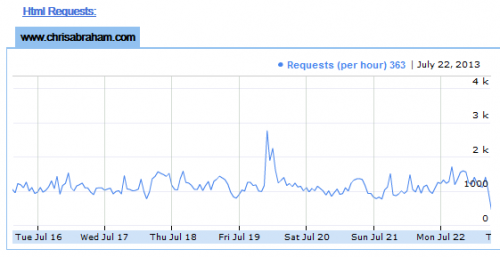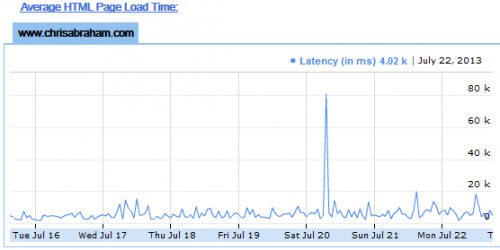People are obsessed with SEO — which is weird. Just a few short years ago, SEO was considered snake oil. I have been designing and implementing SEO strategies since the mid-90s when SEO included lots and lots of directory submissions and quite a lot of compassion for people who were stuck on dial-up with PCs that could only deal with small, low-resolution monitors. Now, both online reputation management (ORM), something I have been doing since 2003, and organic search engine optimization are both essential services, though I fear that too few really consider all the variables when they purport to having deep knowledge of the state of the art.
This was embarrassingly obvious when I attended Vocus’ Demand Success 2013 conference. Mind you, it was awesome and so worthwhile, but it’s a communications conference and not a tech conference. There were quite a few panels and presentations about SEO, it’s true, but none of the presenters who were discussing search were technologists. Their SEO expertise was limited to content: how to optimize content for Google using linking, surfing Google trends, keyword diversity, as well as a little bit about organization, structure, and maybe something about Google Webmaster Tools — however, you’re never going to get to the top of Google’s Hit Parade if you don’t understand that Google is well-past all the trickery and all the surfing and has finally been able to boil it down to the essentials: users must get what they’re looking for without needing to wait. Needing to wait? Yes. You can have the most perfectly-tooled website, wired for sound and optimized to within an inch of its life, and if the quality of hand-off from Google, which is optimized for speed, to your site, which may well be optimized for content, is slow — meaning your site’s a pig with tons of plug-ins, no caching, and living on an over-taxed shared virtual server in a discount data center that’s nowhere near the backbone of the Internet — then Google will always err on the side of speed — Google knows that all visitors always blame Google for any experience that’s not instantaneous and that it’s almost never Google’s fault — it’s almost always the hand-off to the target site the visitor chooses.
So, Google knows that it’s being judged more on the smooth transition from search results to website. Google also knows that the top result receive exponentially more clicks than the second result which receives exponentially more clicks than the third, and so on.
The same goes for PPC as well. One of the variables as to how much you pay and whether Google puts your listing at the tippy-top of the results has a lot more to do with your site speed, content-latency, and the number of milliseconds it takes for the initial request to result in a fully-rendered website (including, remember, every single image, JavaScript, social button, badge, plugin, and separate database call).
OK, OK, I am really geeking out, aren’t I? See, I am not just a PR guy. I was born in the furnace of Linux, BSD Unix, command line, bash, SSH, application development, Perl, Python, Apache, MySQL, and even PostgreSQL — which is how I know that this obsession with content marketing and very front-end solutions for search optimization come up short.
There are some important things to consider if you want to take your fully-realized and powerfully-optimized site to the next level and give Google what it really wants: customer experience satisfaction.
- Google Page Speed Report — when Google has an entire site dedicated to something, it’s important — and if you’re not a Google Developer then you need to become one or you need to hire one to help you — and they guy to hire isn’t necessarily the same guy who does your paid search — they’re two different skills.
- The Quickest “Box” You Can Afford — while you probably spend loads of money on content-creation and site maintenance and on community management, PR, marketing, social engagement, paid search, and advertising, you’re probably rocking the same hosting package you’ve been using since you started your company and that server’s only costing you $4.99/month and it’s a virtual server that you share with a hundred other companies — or it’s a virtual server in a cloud somewhere. And why do you need any more, you’re well within the specs. Your site isn’t more than 5 gigs and it’s not like you’re running a newspaper. Well, Google doesn’t care about anything except your merge. And even though you don’t need a Porsche to do your daily commute, you might need a Porsche if it’s the 0-60 quickness you need: the new 911 Turbo S makes 0-60 mph in 2.9 seconds — and if that’s the merging speed that Google needs for the hand-off from their rocketship servers to your site, you’d better spend your money on the quick even if you don’t anticipate your site ever getting “slash-dotted” or “reddited” or swamped from a social mention by BuzzFeed or The Drudge Report.
- Does Your Host Have Backbone? No matter how quick the box is, it doesn’t matter if the data can’t get from you to Google and from Google to your visitor. The data latency slows down the experience of the site — and pisses Google off. In much the same way that high-frequency trading (HFT) demands supercomputers with huge data arrays and blistering computing power, all of that’s for naught if it can’t win the race to the market data — so, these companies are camping their Crays right outside the real-time market — and paying extortionate fees for access — in order to get the freshest market data into their computers and back as fast as the speed of light allows. It’s much the same way when it comes to Internet bandwidth: the best data center is called Tier 4. Tier 3 and Tier 4 data centers tend to squat on the backbone of the Internet so as to minimize the latency between data requested and data delivered. This is also why websites take it even further by “cheating” and replicating their content all over the globe through services called Content Delivery Networks (CDN). Companies such as EdgeCast, Cachefly, and Akamai work in much the same that FedEx and UPS work these days: they maintain web content inventory locally — as close as possible to large online populations globally — so that someone who is visiting a site for content doesn’t need to pinball all around the internet — called bounces — and have virtually a direct route. And while sometimes the content may be a little stale, as the site content on the CDN sync, it can sync once-per-second and still offer a better “static” experience to visitors — and, of course, a stellar pass-off between Google and the CDN-backed site. See, Google’s not always fair. It surely does offer higher rankings to sites that are spending infinite sums on site performance and content delivery. While you might not be able to compete with Yahoo! or AOL, I am sure you can do better than you do right now.
- Cache Everything — if you’re hosting your own database-backed website on platforms such as WordPress or Drupal, you need to install a caching plugin, in the case of WordPress, or you need to turn on caching, if you use Drupal. You also need to allocate as much RAM/memory as possible to PHP, MySQL, and see if there are any other ways you can optimize your caching strategy by using disk-caching and possibly a lightweight server balancing or CDN strategy. I recommend W3 Total Cache if you’re a big geek or have access to a propeller-head who can hook you up with some serious back-end support, help you hack your file-system, edit your php.ini file, hack your Apache httpd.conf file and all the other fun stuff that is required to make sure your data-backed website is fully optimized and completely cached so that you can be the quickest site you can be. If you’re not so much of a geek, people have really good luck with installing WP Super Cache — it does very good work and is very user-friendly (and installing it almost never breaks anything).
- Your Plugins are Lead Weights — I love plugins, I do. I would love to have a million of them running on my blog — but I have given up on that because I want people to actually get to my site via Google search more than I want to entertain the bloggers who arrive. I know that “if you like this then you’ll love this” links and real-time tweet embeds and all of the other 3rd-party plugins are very sweet, but if they end up accessing your database a lot and slowing down the responsiveness of your website thereby scaring off Google, what’s the extra functionality worth to you? Would you rather deactivate or delete some of the non-essential plugins to gain some speed or would you prefer to throw money at the problem by adding caching strategies, getting a better, faster, and quicker server, adding loads of ram as well as disk-caching? It’s all a trade-off.
- Does Your Site Rely on Off-Site Content? Here’s the scary thing: all of those social buttons have images, GIFs, and graphics that are possibly hosted on someone else’s site — even if that site just happens to be Twitter.com, Facebook.com, or Plus.Google.com — it doesn’t matter. If Google Search’s performance-monitoring tool sees that your site’s bogged down because you’re waiting on third-party CSS, content, graphics, images, and Javascripts then you’ll get the demerits and not the other hosts. Is there a way that you can mirror things onto your server? Is there a way to cache is locally? Is there a way to turn it from being dynamic to static? Is there a way to remove it or replace it with something better-optimized?
- You Can Separate Out Your Essential Processes — this is pretty advanced stuff but can you put your MySQL database on a different server than your Apache webserver? Can you host your images from a separate box? Is there any way to dedicate processes to different servers so that they don’t all have to fight for limited resources? A cache box, a graphics box, an Apache box, a database box? I know, that’s a lot of boxes.
Well, I am out of time for this post. There’s so much more to cover but I think I should put down my pencil. Just remember that if you spend all of your budget just on content-creation and traditional on-site search optimization and don’t work hard on improving your back-end, you’ll be spinning your wheels and you’ll end up being frustrated!
We constantly talk about how important social is when it comes to Google search and how important it is to own your space on Google+ business pages — and it is! However, one of the reasons why this is the case is because Google’s tired of waiting for all the content sites it relies upon to ever be able to live up to itself so Google’s hoping it can create branded micro-sites on all of our behalf — so Google can control all of these variable — so that Google will, at some point, never need to pass the ball from its ecosystem (rock-hard and 100% reliable) to yours (really, a mixed bag).
But, until then you can work on making Google your BFF — first, go sign up for Google Analytics and get to know it some — and see if you can tie it into your site; or, if you already have, you can learn a little more as to what Google cares about — look at Google Analytics as a type of mirror for you. Then, check out Google Webmaster Tools, something you should already be exploring. Finally, you need to take a look at Google’s PageSpeed Tools — they have lots of bells, whistles, tests, even Google’s new PageSpeed Service (sort of a Google-sponsored CDN, which is very cool — www.chrisabraham.com uses it!):







